Summits & Skylarks
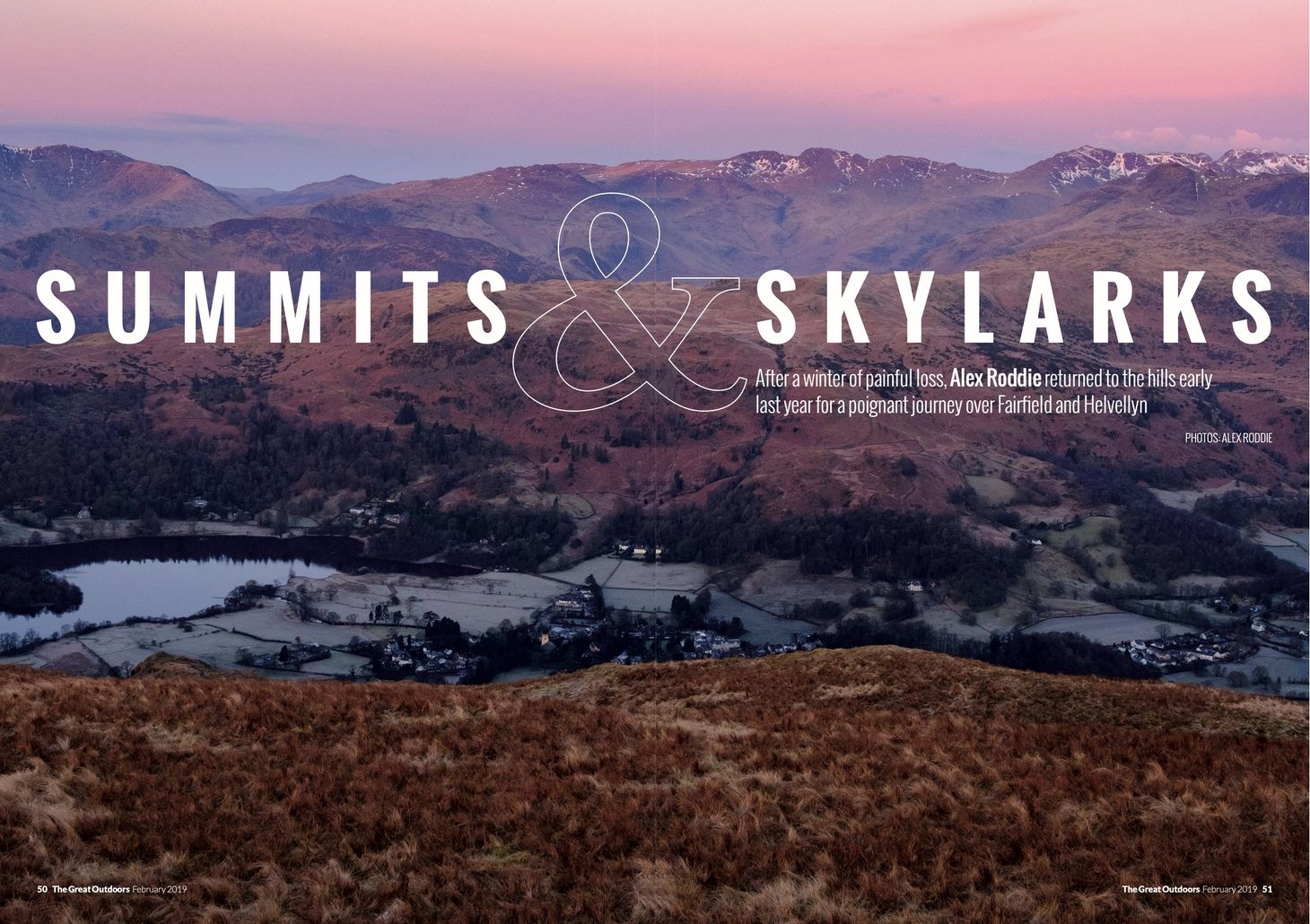
After a winter of painful loss, Alex Roddie returned to the hills early in 2018 for a poignant journey over Fairfield and Helvellyn.
This feature was first published in the February 2019 issue of The Great Outdoors. In October 2019 it received the Outdoor Writers and Photographers Guild Award for Excellence (Outdoor/Travel Feature). Read more about the award here.
The last book I gave to my dad to read before he died was Among the Summer Snows by Christopher Nicholson. I’d read and reviewed it for TGO in late October 2017, which was a hard time for us – we’d just found out that Dad’s cancer was almost certainly terminal. The book made an impression on me that’s hard to articulate, with its beautiful writing and symbolism, and I knew that my dad would want to read it too. But my urgency for him to read the book was less about the book itself (exquisite though it is) and more about the need to communicate with him about the big, scary subjects: mortality, permanence, legacy. Things that are hard to put into words until a book comes along that says them better than you ever could.
Dad finished reading Among the Summer Snows in a week, and when he gave it back to me he said he was struck by how extraordinarily gentle and yet profound it was. For all my life, we had bonded over books, but this was to be the last.
Journeying uphill
There’s something magic about heading uphill when everyone else is heading down. After a bitter winter of heartache and at times near-unbearable strain, after the so-called ‘Beast from the East’ had come and gone, I finally returned to the mountains that had been so far from my thoughts – and yet also very close. Part of me had yearned for a little mountain healing, but not until March 2018 did I find myself climbing Nab Scar in the crisp light of the golden hour. As a viewpoint, everybody loves Nab Scar: a short climb from Rydal will reward you with gorgeous views down to Windermere and across to the big peaks at the head of Great Langdale. I took plenty of breaks on my way up to admire these familiar, beloved sights that had been friends to me for so long. I smiled hello to runners, dog walkers and hikers on their way down. One told me of a good spot to camp near the summit of Heron Pike. I pressed on, eager to find my night’s halting place before sunset.
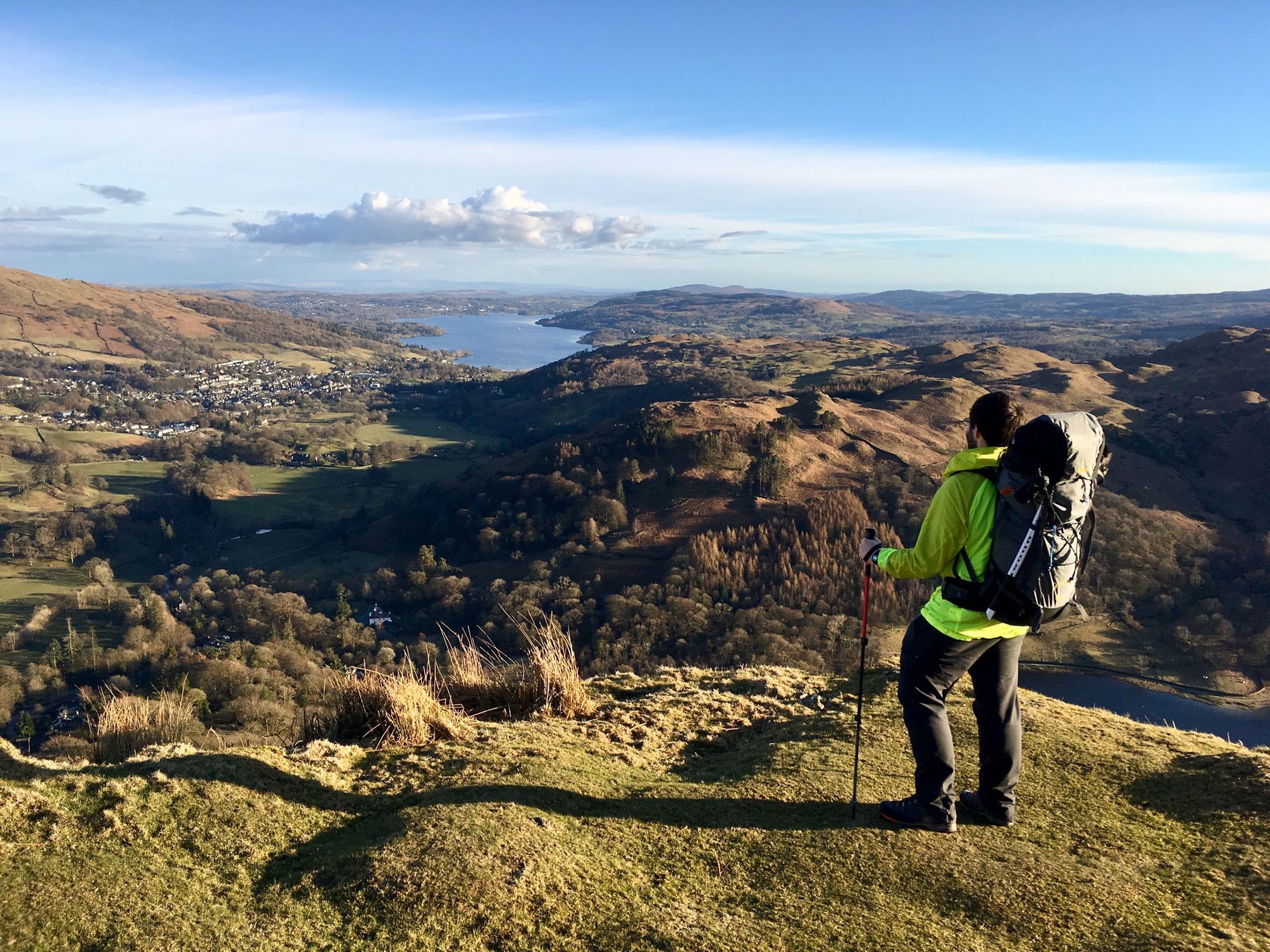
You might think that this return to the hills would be a bittersweet experience, that reflections on my dad’s death would constantly be rushing to the forefront of my thoughts. But here’s the thing that everyone tells you but that never makes sense until it’s experienced: grief is complex. At that moment, striding along a Lakeland ridge with the sunset just starting to smoulder away beyond the Coniston massif, the loss I’d felt so keenly was a long way from my mind. If I thought of it at all in those few hours, it was perhaps to reflect that this trip marked a watershed, a conclusion to my own personal grieving. It took me longer to realise that this was only the very beginning of a lifelong process.
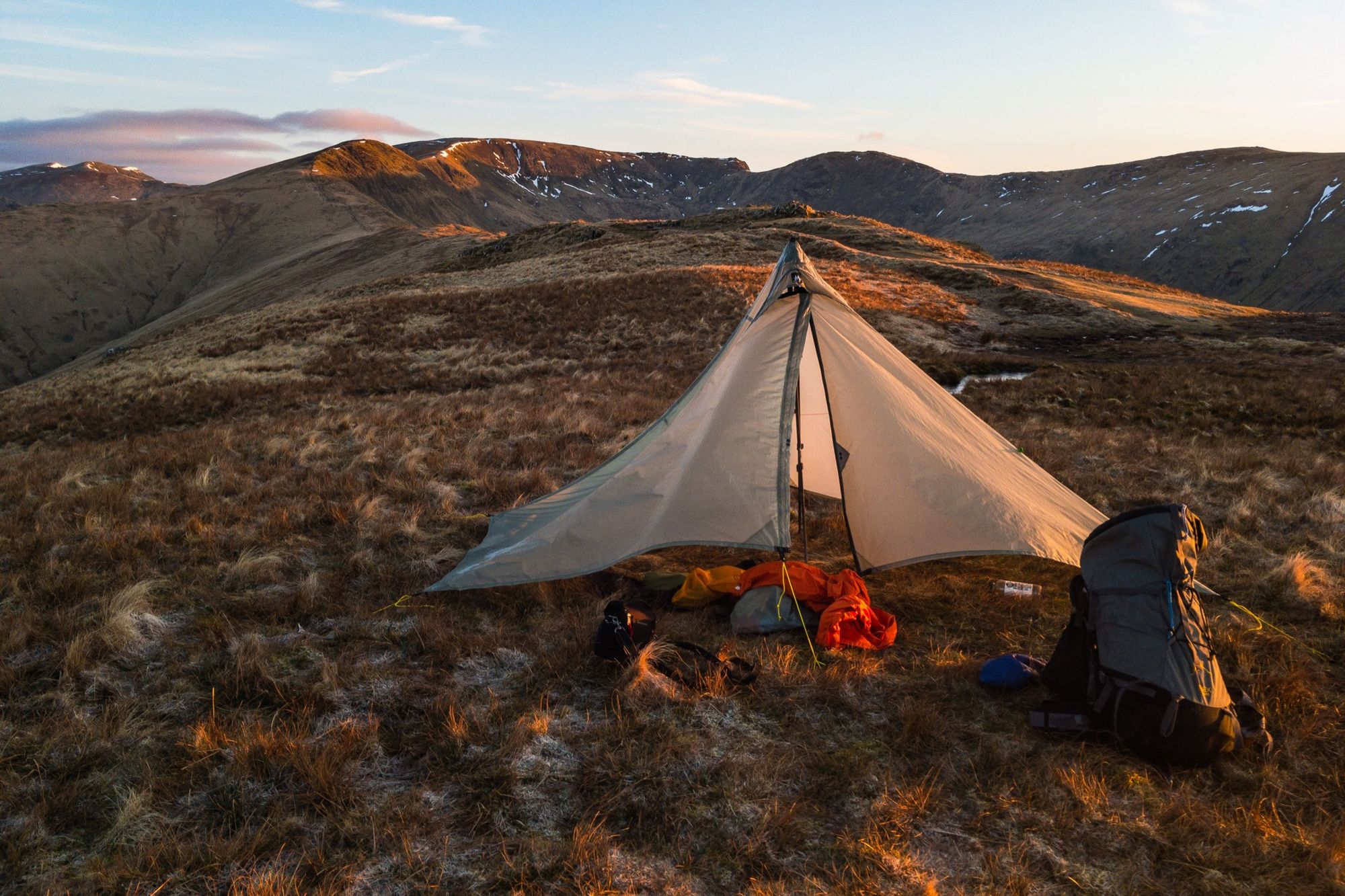
My plan was simple: walk from Rydal to Keswick via the Fairfield-Helvellyn ridge. It’s a route I had long wanted to do – ever since, some 15 years ago, on a family holiday to the Lake District, Dad had pointed out Helvellyn (from its more pedestrian Thirlmere side) and I’d asked him about walking routes to the summit. That big ridge we’d driven alongside looked great on the map. After years of not really thinking about it, I’d made tentative plans to make the trip that January, but life intervened. By the time I finally felt able to return to the mountains, most of the snow had gone, but I was hoping that Helvellyn’s crown would have retained its wintry splendour.
As the sunset faded and the stars came out, I buried myself under my down quilt against the frost. A night spent high amongst the mountains can be many things but ultimately it always comes down to keeping warm and dry on a fairly level spot until it’s light enough to walk again. I set my alarm for just before sunrise and turned in.
About the route
- Start: Rydal. GR: NY364061
- Finish: Keswick. GR: NY263235
- Distance: 19.7 miles / 31.7km
- Ascent: 1716m / 5631ft
- Wainwrights: Nab Scar, Heron Pike, Great Rigg, Fairfield, Dollywaggon Pike, Nethermost Pike, Helvellyn, White Side, Raise, Stybarrow Dodd, Watson’s Dodd (optional), Great Dodd (optional), Clough Head.
- Maps: OS 1:50,000 Landranger sheet 90 (Penrith & Keswick), or Harvey’s Lake District Mountain Map (which I recommend)
- Route notes: This is a classic big mountain ridge and makes a superb outing at any time of year. With multiple summits and plenty of ascent, it’s a big day out even in summer; in winter you’ll want to get an early start. While non-technical, there is steep and loose ground in places, and in winter an ice axe and crampons are required. In hill fog, navigation on the featureless plateau should be taken seriously.
Early morning on the fells
The dawn was one of extraordinarily subtle colours that washed through the hoar-frosted silnylon of my shelter. Delicate pastel shades blossomed; first reds, then oranges and yellows. I hurried to pull on my boots, grabbed my camera and escaped from my tent. As I fumbled with my tripod, a rose glow spread down from the summits of Crinkle Crags and Bow Fell to gradually fill the frosty glens beneath. The weather gods were smiling on me.
Despite the winter gear weighing down my pack, I didn’t set foot on any snow until high on Fairfield – and even then it was only a patch, baked hard as terracotta by sunshine and frost, compacted by boots. When I kicked at the surface it had some bite to it, nothing like the sugary, thawing mush of early summer that must yield a little more to the inevitable each day. This patch asserted itself with a satisfying crunch each time I took a step, as if it knew there was still everything to play for, just waiting for one more wintry blast to bolster its strength.
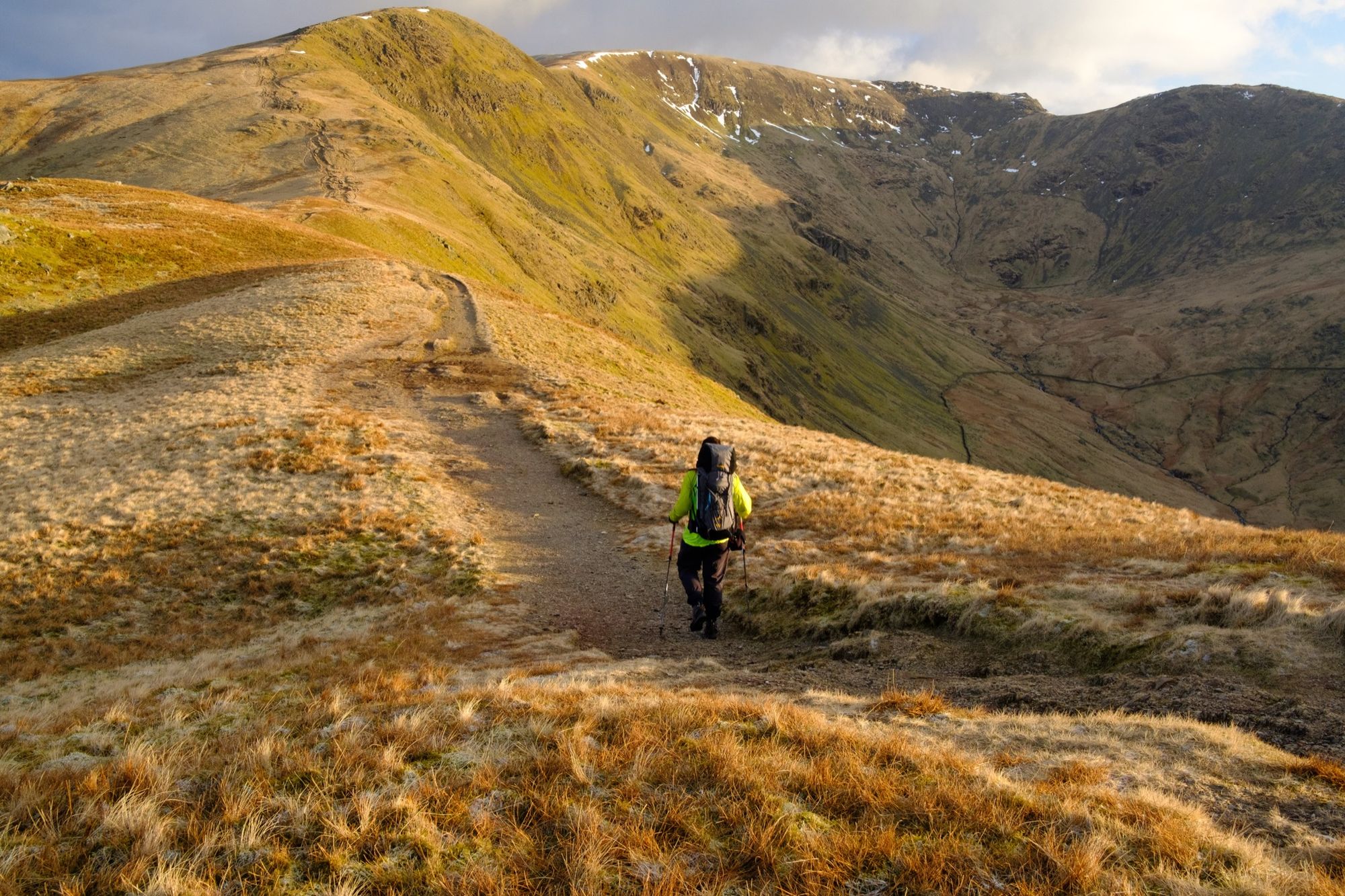
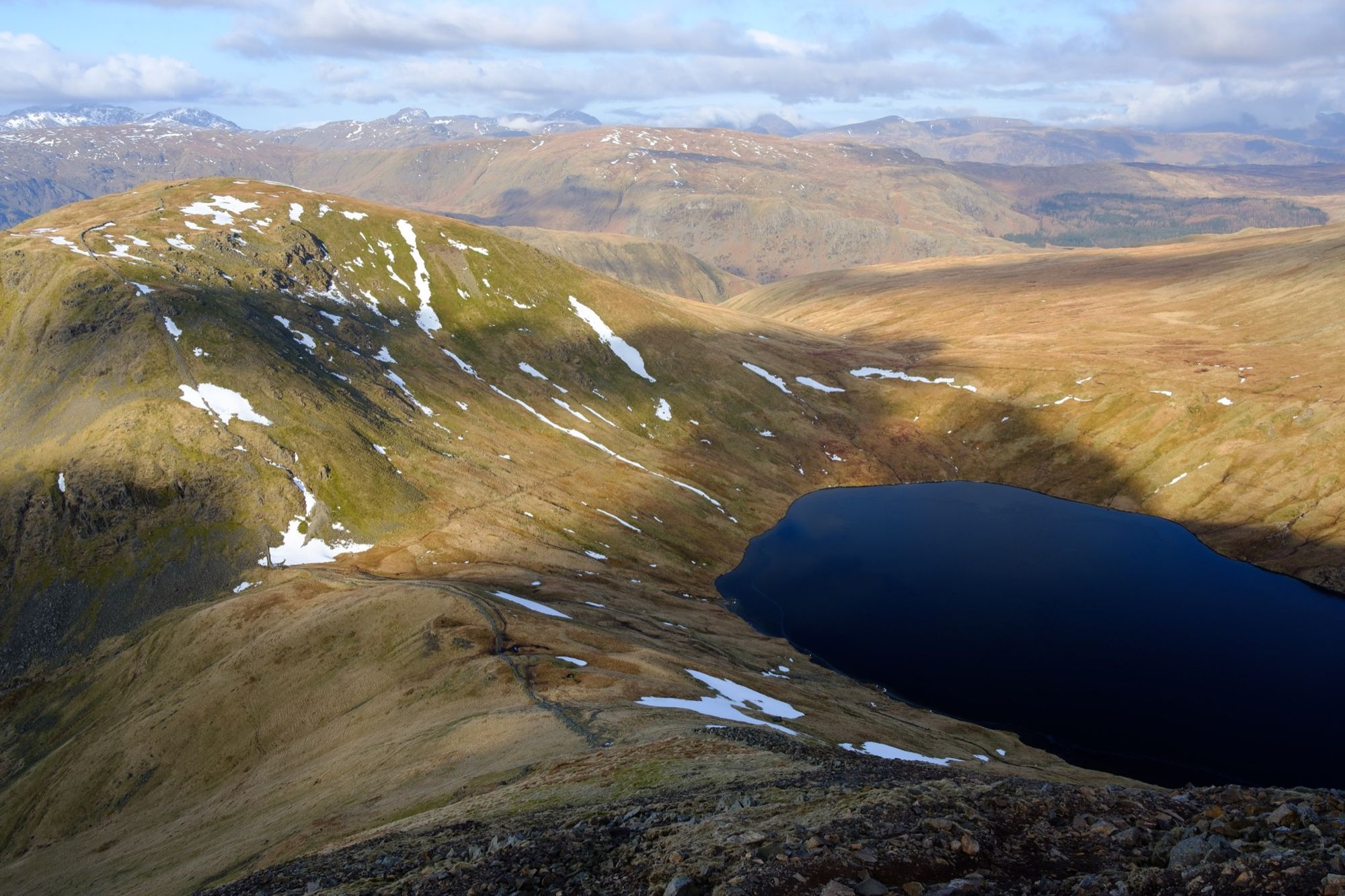
On the steep and loose descent to Grisedale Tarn I met a group of early-bird fellrunners, clawing for purchase on the frozen scree. We exchanged a few words, but they were concentrating on getting enough oxygen to hard-working muscles and I was focusing on staying upright on the shifting surface beneath my boots, each of us no more than spectators in each other’s world. Grisedale Hause felt like a cold and hostile place when I reached it – scoured monotone slopes, bogs that crackled with ice, and long sweeping banks of snow that led the eye nowhere.
The pull to Dollywaggon Pike warmed chilled muscles but closed me in from views that I felt must be unfolding to the east and west. Above, the snow took on a bolder character, more sure of itself now as I climbed up into its fortress where the assaults of wind and rain made little difference other than to galvanise its carapace into a shield, harder still against the coming thaw.
By the time I’d broken out onto the ridge above and was crossing Nethermost Pike’s keel-like bulk, the snow’s dominance was beyond question. The ragged stub of a cornice rim decorated the eastern ridge as I climbed higher. It was just enough to remind me to stay back and watch where I was putting my feet. Those views I’d craved made me wait a while longer; cloud blew in and veiled the ridge with a damp and chilly atmosphere, as if to hammer the point home that this was still winter.
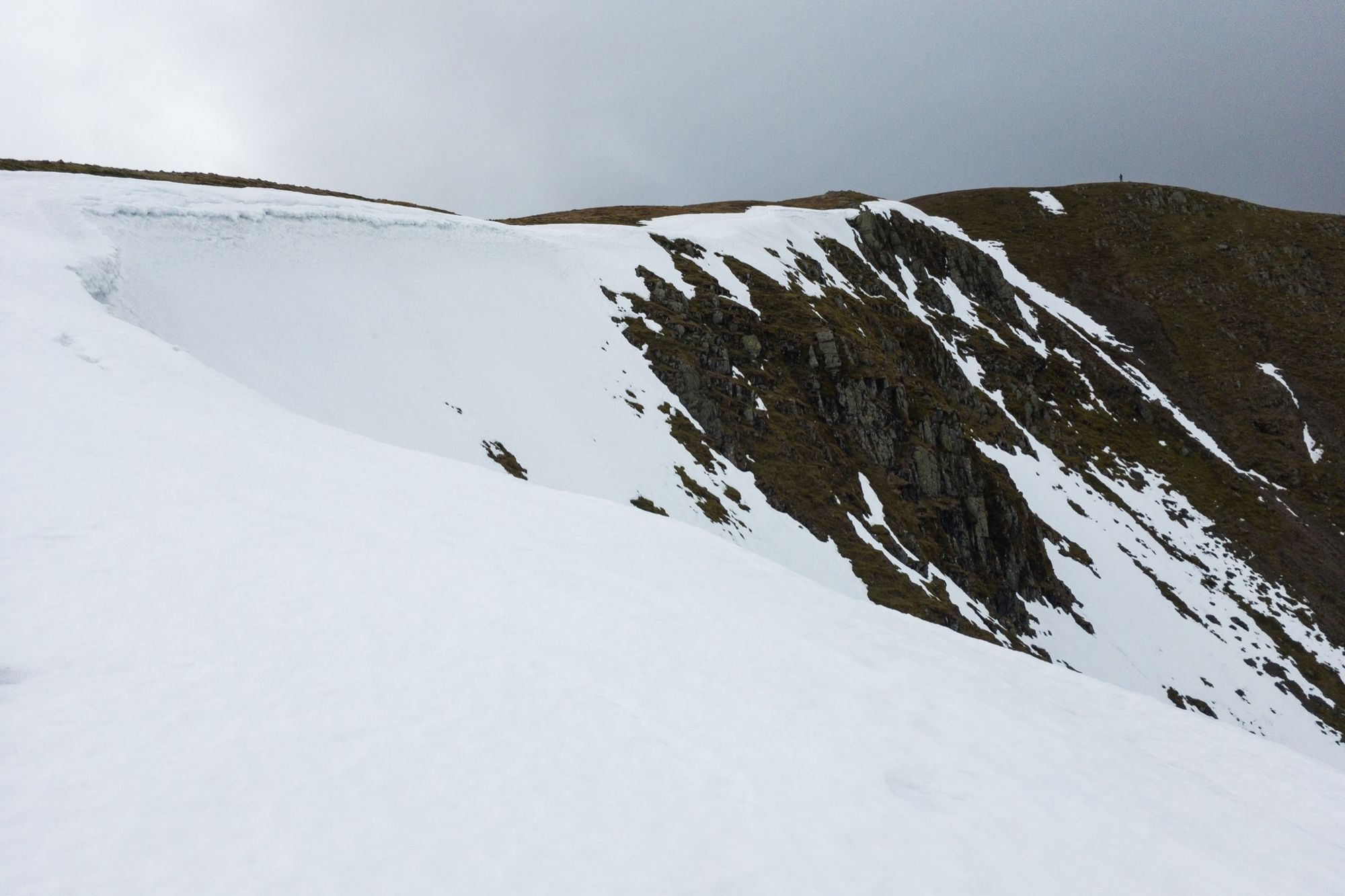
I’d forgotten how busy Helvellyn could be. As I progressed along the ridge, it got busier: backpackers coming down from a wild camp; climbers topping out from Striding Edge and crossing the well-stamped snow towards the summit in their crampons; even a squad of mountain bikers on their fat tyres, plotting a careful course between protruding rocks. I’m not usually one to appreciate a social experience in the mountains, but I found a certain comfort in the thought that so many people had ignored the snow-free, springtime charm of lower fells and come instead to this isolated bastion at the end of a long winter – perhaps answering some deep and primal call from within that drives us to seek the ice. Or is it the snow’s very defiance and survival, though ultimately doomed, that we respond to, even if we aren’t aware of it? In Among the Summer Snows, Christopher Nicholson wrote of our fascination with Scottish glacier legends: “What fuels the debate is the aching desire for survival. We admire longevity… because we long for it for ourselves.”
These ideas nudged at the conscious layers of my mind as I stopped at the summit for a bite to eat. I was distracting myself by making a video of this trip and spent too much time faffing about with microphones and trying to keep my phone’s battery warm. So much of our experience when among mountains is submerged, perceived only hazily, until time reveals the deeper currents that influence us.
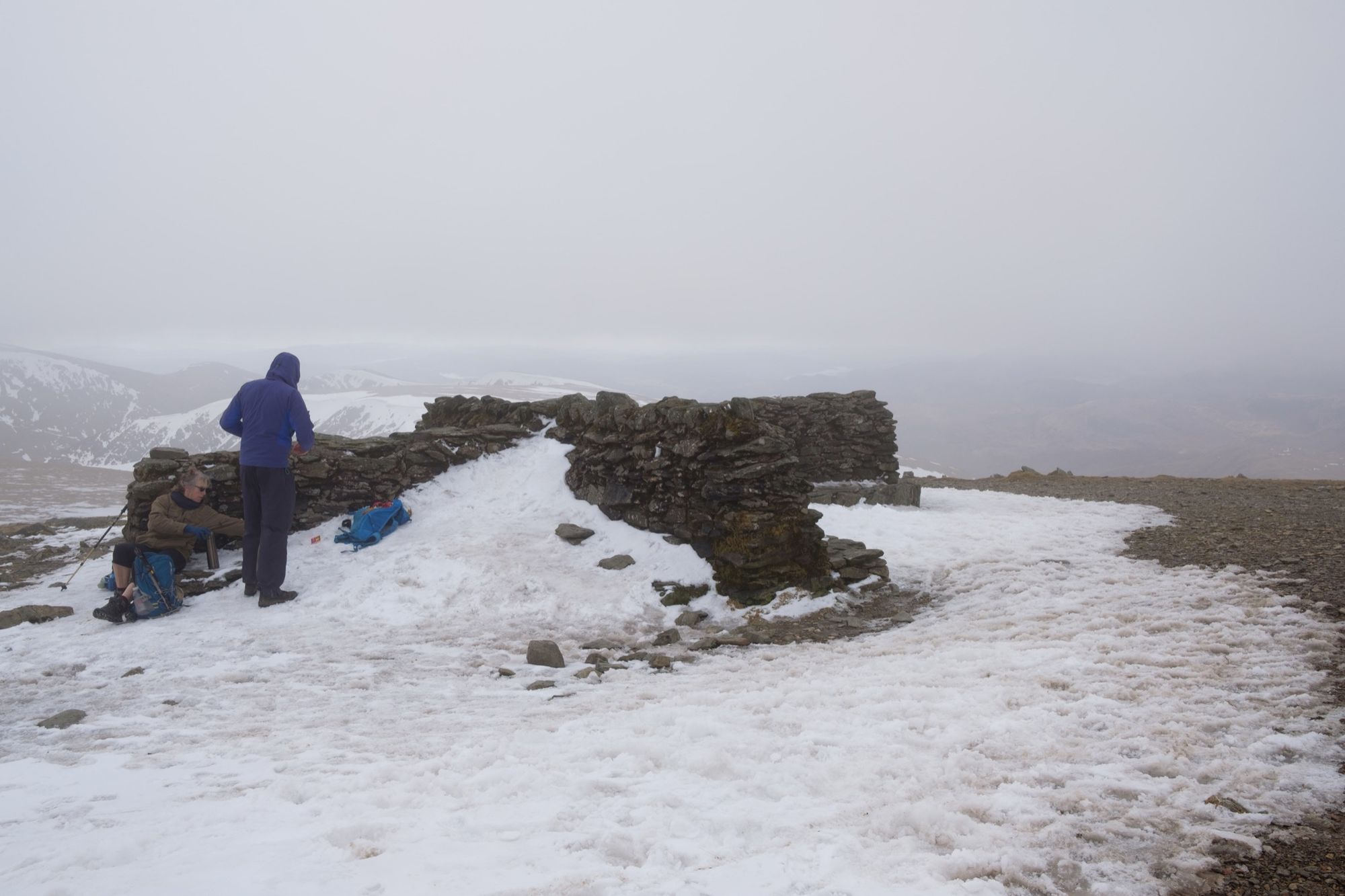
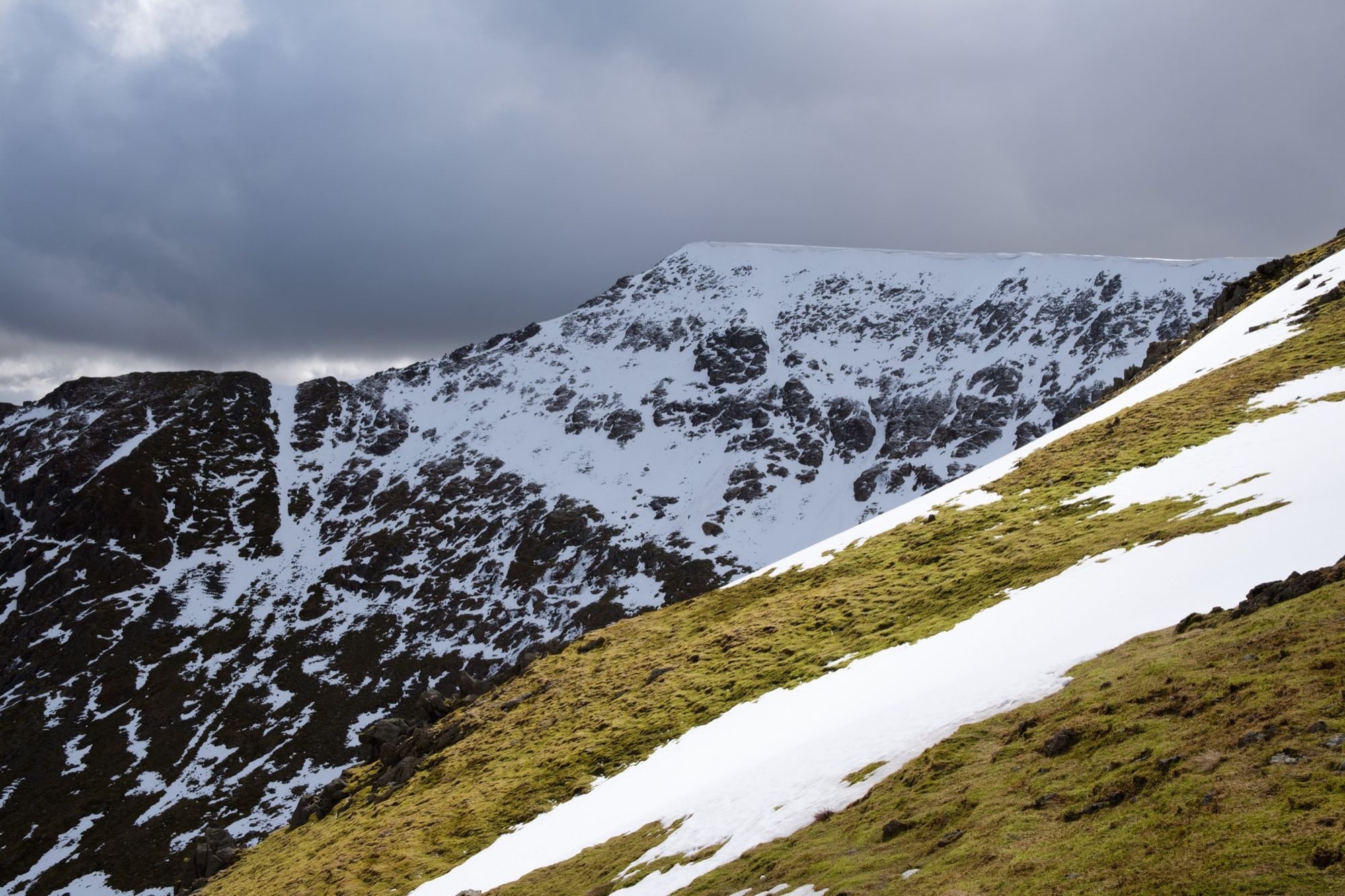
As I travelled north from the summit, that big ridge unfolded before me and the views opened up too. Swirral Edge looked impressive in profile from Lower Man. I watched climbers pick their way along its snowy crest while the view below, past the snow patch-flecked flank of Catstye Cam, receded to springtime valleys. A skylark’s song reached my ears on the breeze.
A solitary wander
I’d managed to avoid getting ice axe or crampons out until this point – the path was well stepped-out, the terrain easy – but the steep descent along the ridge of Browncove Crags threw an obstacle down in front of me. For a short distance, the ground became a lot rockier and icier, and I decided to get my ice axe out to hack a few steps. Just like that, I’d escaped from Helvellyn’s island of winter. There were more snow patches to be seen on the gentler, rounded hills to the north, but nothing like Helvellyn’s brash ice cap – or at least nothing visible. I soon had the fells more or less to myself again as I strode out over easier trails.
Far below me to the left I could see Thirlmere. I thought about that family holiday a lifetime ago, about that hot day in summer 2003 when Dad pointed Helvellyn out to me and my brother James. We weren’t hillwalkers then, not really, but Dad had dragged us up a few of his old favourites in the Yorkshire Dales, and stared wistfully across at others from places I now realised must have been the cherished viewpoints from another life. Though the mountains don’t change, we project our own changes onto them. My dad had given me so much in his life, and as I stood there gazing down at Thirlmere and letting these thoughts bubble up from their depths, I grasped at the truth of my own grief: this trip was certainly not its conclusion, because grief doesn’t come to an end. It only changes, as we change.
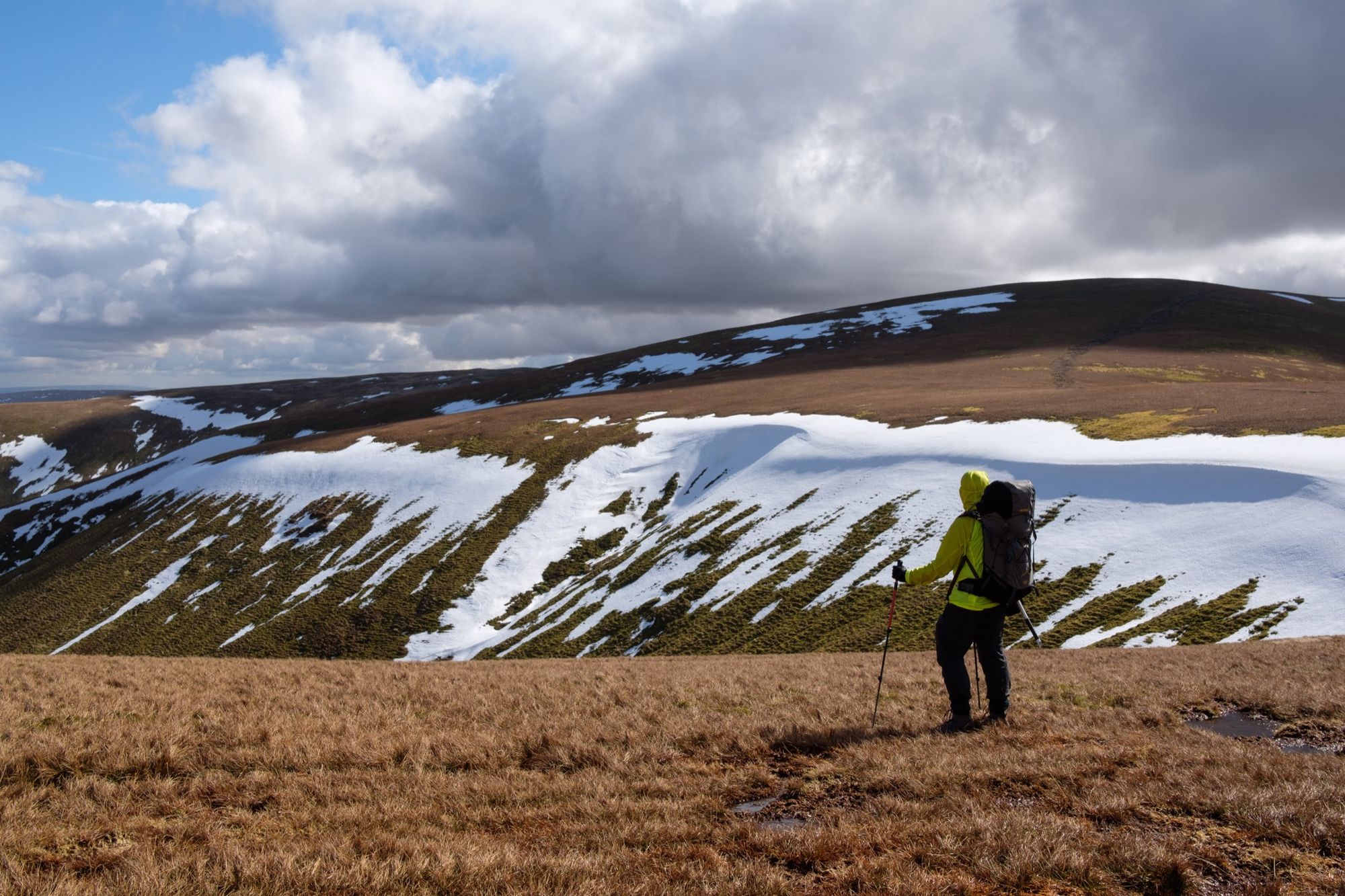
My walk north over the rolling forms of Stybarrow Dodd and all the others was as bittersweet as the start of my journey had been oblivious. Sunshine and blue skies contrasted with those last few snowbeds, clinging on in sheltered gullies. The raw cruelty of cancer seemed like an impossibility in this place – and yet there are submerged truths here too, white lies we tell ourselves about the unsullied beauty of Lakeland. Mountains themselves are indifferent, and their ecology has been degraded by industrialisation and overconsumption. Like life, there’s more going on than you can see on the surface, and we don’t always want to look too closely in case we see too much.
Did you know that I send out weekly newsletters on the outdoors, writing, and outdoor writing? Subscribe here to receive my Pinnacle Newsletter.
Those were my thoughts as I rounded a corner and came face to face with one final obstacle: a deep bed of snow that curled in an arc around the top of a gully, drifted deep over the path. The surface was hard and once again I had to get my axe out and cut steps, conscious of the nasty run-out to my left. Something about this hidden snow patch brightened my mood. It disrupted the narrative I’d been building in my head, of Helvellyn’s fortress of ice – this snow patch was on a different hill and at a modest altitude, and it didn’t care about my metaphors.
Clough Head was my final summit of the day, with delicious views to Skiddaw and Blencathra. Skylarks trilled overhead. The sun was warm on my back and it felt a lot more like spring than winter, but as I looked north I couldn’t help but feel glad that remnants of cornices were clinging on to the clifftop rims, defiant. It had been a day of more thinking than I’d bargained for, but ultimately it had come down to this: standing on the summit of a Lakeland fell, appreciating how good it felt to be alive and in the open air. Sometimes the simpler things are all we need to feel whole again. Sometimes a snow patch is just a snow patch and a hill is just a hill.
In memory of Ian Roddie, 1938-2018
All images © Alex Roddie. All Rights Reserved. Please don’t reproduce these images without permission.
Alex Roddie Newsletter
Join the newsletter to receive the latest updates in your inbox.




